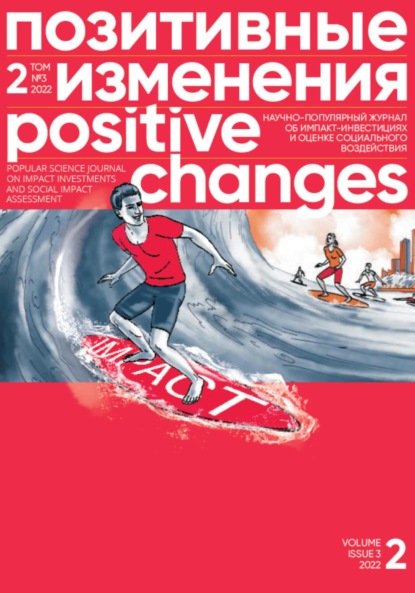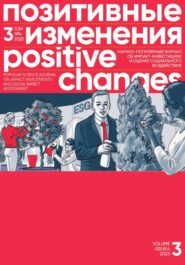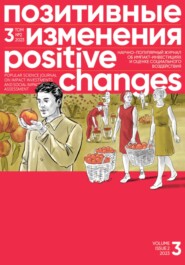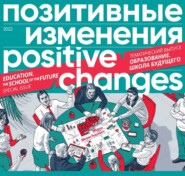По всем вопросам обращайтесь на: info@litportal.ru
(©) 2003-2024.
✖
Позитивные изменения. Том 2, № 3 (2022). Positive changes. Volume 2, Issue 3 (2022)
Настройки чтения
Размер шрифта
Высота строк
Поля
The Asian Venture Philanthropy Network (AVPN) is a Singapore-based social investor network aimed at building a community of social impact investment projects across Asia.
The Association’s main mission is to increase the flow of financial, human and intellectual capital into the social sector by uniting and empowering major shareholders. It uses such tools as capital pooling, community building, and organizing events to disseminate knowledge and best practices of the practicing network members.
AVPN has more than 600 members from 33 countries. “Our Future” Foundation was the second participating organization from Russia. Most participants are geographically located in Asia, but some come from North America and Europe.
Participation in AVPN provides the following opportunities: access to events organized by AVPN; opportunities to communicate with investors and make joint deals through the Deal Share platform; access to educational materials, case studies, and analytical materials.
The Euclid Network is a European network of leaders in social entrepreneurship and civil society that was founded in Paris in March 2007. It brings together organizations from 31 countries, including representatives of social organizations and associations of social enterprises, universities, non-governmental organizations, social enterprises, and social investors. “Our Future” Foundation became a member of the Euclid Network in 2019.
It is important for social entrepreneurs to be able to independently analyze social outcomes and ways to achieve them.
Membership allows access to members-only content, such as the Managing Positive Change webinar series, insider knowledge, advice and support on impact measurement and social innovation. The Euclid Network makes it possible to find partners for joint research, and to share experiences at joint events.
In one of your interviews, you said that when providing financial support to social entrepreneurs, the Foundation pays special attention to such an indicator as the degree of social impact. How do you measure it?
Here I would like to mention that the Foundation has many different programs of financial support, and each program includes an individual approach to developing the criteria for evaluating projects. But, of course, social impact is always at the top of the list. If we talk about return on investment in existing projects, we need the evidence base of the declared social effects of the project, for example, laboratory-confirmed environmental friendliness of the products, scientific evidence of the usefulness of the applied methods of preschool development, the presence of reliable positive feedback on the work of the project, etc. We further analyze a number of the largest projects using the SROI (Social Return on Investment) methodology. If we talk about supporting projects at the startup stage, we rely on the predicted values of the effects, comparing them with the available results base from other projects in the same field.
At the same time, Russia still lacks a unified system of indicators and methodology for measuring positive social impact. What do you see as the solution to this issue?
It is important for social entrepreneurs to be able to independently analyze social outcomes and ways to achieve them. “Our Future” Foundation uses complementary methods: assessing results per ruble of invested funds when comparing alternative investment projects in the same area, as well as a method for evaluating the social return on investment and a method for rating social enterprises after they receive funding.
The Social Return on Investment (SROI) method is well-suited for analyzing the entrepreneurial and social components. It takes into account the social results of the enterprise in monetary terms, includes a comparison of invested resources and results obtained. For a SROI of 3:1, every ruble invested in the project results in three rubles’ worth of social impact. Money, in this case, acts as a universal means of expressing value, so that a complete picture of impact can be presented. We do a forecast calculation for large investments, and then after the funding period is over, we summarize the results by comparing them to the forecast data.
The application of SROI makes it possible to visualize and analyze changes. At all stages, SROI serves as a tool for communicating with our customers, employees, communities, and the government. This kind of feedback helps manage risks, improve products and processes, and find new lines of business.
The Foundation uses a rating system for interaction with social enterprises after the funding has been provided. The projects are rated based on the promptness and completeness of the social impact plan, repayment our loans, readiness to cooperate on research and promotion of social entrepreneurship.
The regulation of social entrepreneurship varies from country to country. Some places have laws defining the status of a social enterprise, others don’t. In Russia now, social entrepreneurs also have a special status, but it does not yet include, for example, NGOs. What is your view of the development of the social entrepreneurship model in our country in terms of legislation?
An important step is the expansion of the target groups specified in the law. Currently, the State Duma has passed a bill in the first reading, extending the list of social entrepreneurs to people with disabilities. Further adjustments may be possible in the future, it is important here to constantly analyze and interact across sectors in order to promptly identify the groups that may be added to the registry.
In addition, we continue working with social contractors, who, in fact, are also social entrepreneurs, but are part of a different registry. Combining these registries seems like a good idea, but so far it seems hard to implement.
How does “Our Future” Foundation assess its impact on the development of social entrepreneurship over the years of its work?
We have not conducted a full-scale assessment of the social impact of the Fund as a whole; rather, we evaluated the contribution of its educational unit – the Social Entrepreneurship Laboratory. The study found that for every ruble invested by stakeholders, the Laboratory generates 7.62 rubles of social value.
Globally speaking, almost 900 projects all over Russia have received our help and support in various formats (financing, implementation of the project “More Than a Purchase”, franchising, educational loans, accelerators, etc.). The law on social entrepreneurship and the registry to count the number of businesses have appeared with our participation. Educational programs have started to appear in universities with the support of the Foundation, such as professional retraining courses at the Higher School of Economics. Thanks to the Social Entrepreneurship Laboratory’s Training of Trainers program, 68 certified teachers are currently working in the regions, conducting their own Social Entrepreneurship Schools, which have already produced more than 1,500 graduates. We recently reformatted the course for university teachers, focusing on methodology, and posted it for public access on the Stepik platform. Thanks to “Growth Formula” accelerators (with more than 100 graduates), communities of ambassadors have been established in the regions. These active and successful social entrepreneurs are now joining into local associations (for example, in Astrakhan, Kaliningrad, Yugra). That is also an important part of social impact development.
Экспертные мнения / Expert Opinions
Откуда и как растут социальные предприниматели? Опыт инкубатора импакт-стартапов фонда «Навстречу переменам»
Уже давно слово «инкубатор» в бизнес-среде перестало ассоциироваться с сельским хозяйством, а приобрело значение инструмента по развитию начинающего предпринимательского проекта (или даже просто идеи), позволяющего в пространстве системно-организованной экспертной помощи вырасти в устойчивый проект. Социальные предприятия также не остаются в стороне. Что дает им участие в инкубаторах и в чем особенности программы инкубатора для проектов социального воздействия?
София Шагинян
Руководитель программы поддержки для импакт-стартапов фонда «Навстречу переменам»
ИНДИВИДУАЛЬНАЯ ПРОГРАММА РАЗВИТИЯ ДЛЯ НОВИЧКОВ
Программа «Инкубатор» фонда «Навстречу переменам» предназначена для проектов на ранней стадии развития. Ежегодно ее проходят от 12 до 22 участников. При оценке социального воздействия мы выделяем две группы стейкхолдеров. Первая – импакт-проекты, вторая – дети и молодежь, на которых ориентирована деятельность импакт-проектов[1 - Фонд «Навстречу переменам» с 2012 года помогает развивать проекты социальных (импакт) предпринимателей, которые направлены на улучшение качества жизни детей и молодежи по всей России.].
Для импакт-проектов краткосрочная цель по социальному воздействию заключается в укреплении их организационного потенциала, долгосрочная цель – в выживаемости и масштабируемости.
Для детей и молодежи краткосрочные и долгосрочные цели по улучшению их жизни определяются так называемой «Теорией изменений» импакт-проектов. С помощью этого подхода участники строят гипотезы по изменению в жизни детей, «прикручивают» к ним индикаторы и показатели, продумывают инструменты и план сбора данных.
Участники предоставляют данные по количеству детей и истории об изменениях в жизни детей три раза в год, а в конце первого или в некоторых случаях второго года участия предоставляют данные по оценке социального воздействия.
Развитие организационного потенциала импакт-проектов мы отслеживаем с помощью инструмента, который называется «Трекер развития».
Трекер измеряет развитие в пяти сферах:
• социальное воздействие;
• финансовая устойчивость;
• лидерство и команда;
• масштабирование социального воздействия;
• системные изменения.
У каждой сферы есть свои подцели. В начале года участники совместно с программным менеджером фиксируют исходный статус и цели по развитию для каждой подцели. В течение года обновляют статус на основании фактических результатов.
Чтобы отследить развитие организационного потенциала, фонд также собирает от участников определенные количественные показатели и анализирует их прирост и кратность. К этим показателям, помимо количества детей, относится количество сотрудников и волонтеров, финансовые результаты, охват проектов.
Динамика развития проектов по количественным показателям разнится от года к году, однако, опираясь на данные предыдущих лет, можем сказать, что количество детей, получивших поддержку, традиционно вырастает минимум в два раза в течение года (для проектов, которые на момент старта участия в программе были уже не на стадии идеи или прототипа).
Чтобы отследить выживаемость и масштабируемость проектов, мы отправляем выпускникам «Инкубатора» опросы раз в два года. А чтобы вычленить вклад фонда, мы просим участников отдельно оценить степень влияния программы фонда на их развитие.
Если кратко перечислить используемые инструменты оценки в фонде, то это:
• Трекер развития;
• Специальные формы отчетности и опросы;
• Истории социального воздействия;
• Внутренние исследования;
• Интервью с импакт-предпринимателями, менторами и другими стейхолдерами;
• Опросы выпускников программ: раз в два года опрос всех выпускников разных лет.
Более подробно о системе оценки социального воздействия и о результатах программ можно посмотреть в нашем годовом отчете[2 - Отчет о социальном воздействии 2020–2021. Режим доступа: https://fond-navstrechu.ru/wp-content/uploads/2022/06/otchet-01.06.pdf (дата доступа: 27.09.2022)].
КАК МЫ ПОНИМАЕМ, ЧТО ПРОЕКТЫ МЕНЯЮТ ЖИЗНЬ ДЕТЕЙ И МОЛОДЕЖИ?














